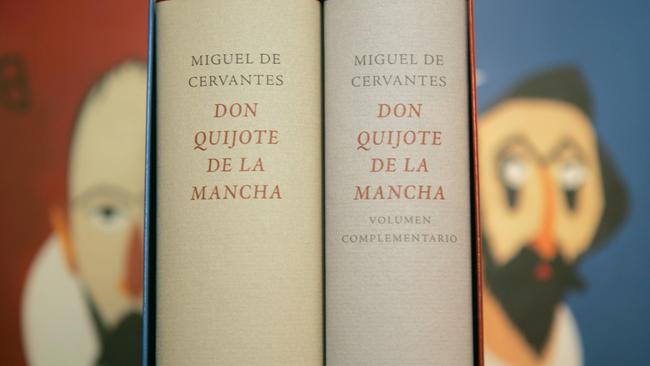Dons pay homage to missing big gun of Western canon
More than four centuries after his death, Cervantes is remembered with holy and literary reverence at his resting place.

A gilt baroque altarpiece glistening behind him, Cardinal Carlos Osoro wafted incense from a thurible and commended the soul of the deceased “to the Lord”. The voices of nuns, invisible behind barred windows, joined the responses. Male choristers sang polyphonic hymns accompanied by harp and cello.
But the funeral mass offered by the Archbishop of Madrid last week at the Convent of the Barefoot Trinitarian Sisters was unusual. Without body or relatives, it commemorated the death of a man 407 years ago.
Yet the solemnity of the attendant dignitaries suggested that the esteem for the departed, Miguel de Cervantes, was fresh.
Among the white beards and walking canes of the Spanish Royal Academy, which offers the annual mass, there was little concern that the author of Don Quixote had recently lost his status as the most translated Spanish-language writer to Gabriel Garcia Marquez.
“Don Quixote is the reference for our language,” Santiago Munoz, president of the academy, the guardian of Spanish, said after the intimate mass. “Nothing better has been written.”
The convent is the core of the Cervantes cult. Tour groups occasionally gather outside but few literary pilgrims dare brave the scowls of its gatekeeper. Cervantes owed his life to the Trinitarian order. He was seized by Barbary pirates as he returned from military service and imprisoned in Algiers for five years. Trinitarian monks finally ransomed him for 500 gold escudos, partially raised by his mother, in 1580.
By that time Cervantes had fought bravely at the Battle of Lepanto, in which his left hand was maimed, but was still more than two decades away from fame.
“The authorities in Spain would have let him rot there,” said Carlos de Blas Armada, an elderly scholar at the mass. “The monks came to his rescue, as was their function. Without them there would be no Quixote.”
Cervantes’s request to be buried in the convent was granted, but at the time of his death, aged 69, and despite his renown, he was poor and the event was largely unnoticed. The remains were lost a half-century later during rebuilding. The lack of a tomb has angered admirers who compare his fate with the well-visited resting places of Shakespeare, who died 10 days later, or Goethe. In 1870 the academy created a commission to find his remains but it was not until 2014 that an archaeological investigation began.
The following year scientists claimed “some of the remains of Miguel de Cervantes are among the fragments” of bones that they had found in the convent’s crypt. But the discovery was not confirmed by DNA tests. His only child died without issue and no remains of his family have been uncovered. “But there is no doubt he is somewhere beneath us,” Blas Armada maintained.
The academy’s commitment to Cervantes is not in doubt. It first said mass for him in 1861, with a sepulchre created for the occasion. On it they placed the habit of the Franciscan Third Order, to which Cervantes belonged in later life, a sword, shackles to recall his captivity, a laurel wreath and a 1780 edition of Don Quixote.
After last week’s mass a party gathered for a wake in a cramped anteroom. From behind a barred window nuns smiled beatifically as guests tucked into cakes and sweet sherry. What Cervantes would have made of it is unclear. The depth of his Catholicism is debatable but, doubtless, he would have enjoyed the praise. Cardinal Osoro, formidable amid the wimples and glasses of Pedro Ximenez, gave his judgment: “Cervantes was among the greatest of Spaniards. And every Spaniard has in them something of Quixote.”
The Times


